BeeLine
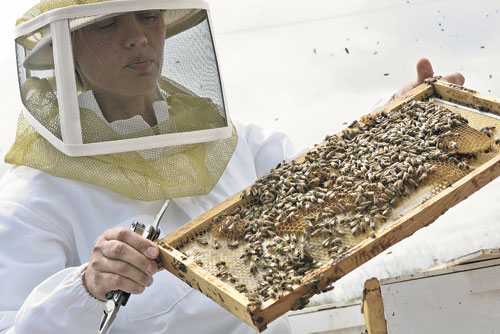
Danielle Downey, an apiary specialist or bee expert with the state Department of Agriculture, inspects hives on the Jefts Farm in Kunia.
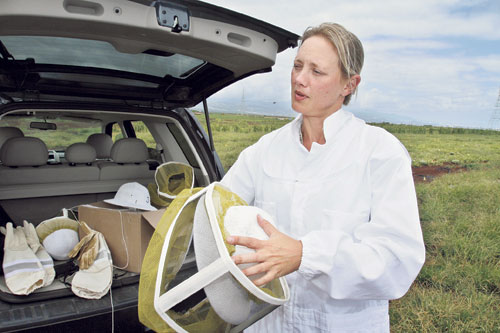
State Department of Agriculture bee expert Danielle Downey dons her protective gear on the Jefts Farm in Kunia.
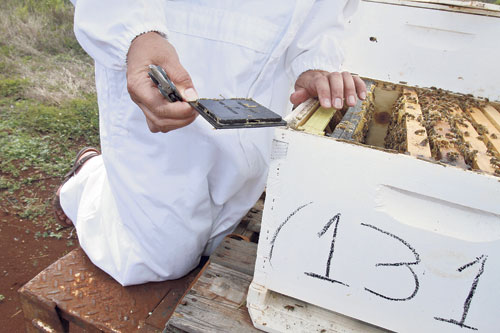
Downey inspects the inhabitants for signs of mites or beetles.
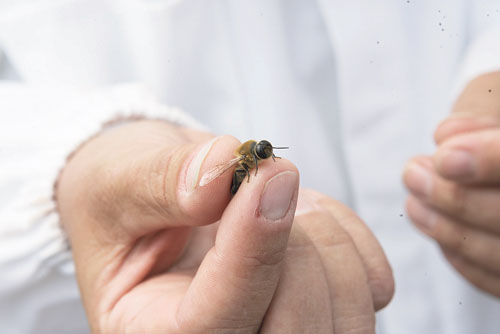
Downey inspects the bees for signs of mites or beetles.
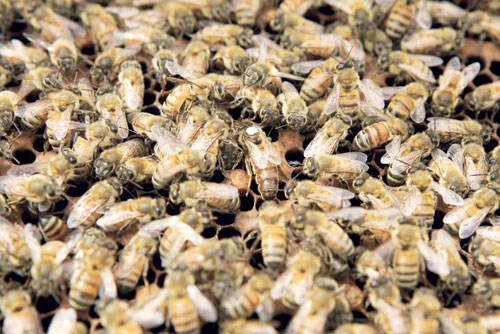
A blue spot identifies the queen bee.

State Department of Agriculture bee expert Danielle Downey boards a truck loaded with beehives.






Danielle Downey climbed aboard a flatbed truck buzzing with the sound of 1.6 million honeybees last week in Kunia and searched for the varroa mite and small hive beetle that have been wiping out Hawaii’s bee population and, as a result, stunting island crops.
Since she took over a new, temporary job as the state’s "apiary specialist" — or bee expert — in December, Downey has been flying from island to island to get farmers more involved in the all-but-forgotten art of maintaining their bee hives to protect them from being destroyed by the varroa mite and small hive beetle.
Farmers rely on honey bees to pollinate their fields and — with Downey’s help — are now learning how to properly maintain their bee colonies to protect both their bees and their crops, said one of Downey’s new fans, Volanda Collins-Toribio, the orchard manager for Island Princess Macadamia Nut Co. in Keaau on the Big Island.
"Man, we really need this," Collins-Toribio said. "It’s so great to have someone so knowledgeable helping you out. Danielle’s constantly teaching me."
The varroa mite, a crab-shaped parasite, was discovered on Oahu in April 2007 by a beekeeper and has since been methodically wiping out entire bee populations by feeding on the blood of adult bees and attacking larvae and pupae.
Then, in April 2010, a Big Island beekeeper on a farm in Panaewa discovered small hive beetles. They feed on honey, pollen, wax, eggs and larvae and damage the bees’ honeycombs, leaving behind a smelly, messy slime that chases the bees from their own hives.
Don't miss out on what's happening!
Stay in touch with breaking news, as it happens, conveniently in your email inbox. It's FREE!
Island Princess was still recovering from its varroa mite infestation — "and then the beetles came," Collins-Toribio said. "Man, that was a different story. It is the ugliest, grossest thing, especially the slime-out. All you see is their maggots in the honey and it’s got a smell to it, too, like rotted citrus. It was an experience. Wow, that hit us so fast."
It’s difficult to calculate the dollar losses to agriculture and bee colonies from the mite and beetle infestations that have primarily hit Oahu and Hawaii island.
But the National Agricultural Statistics Service reported that Hawaii honey production dropped 19 percent from 2009 to 2010 — a loss of 770,000 pounds because of the varroa mite and small hive beetle.
Downey, who is president of the nonprofit Apiary Inspectors of America, estimates there are roughly 10,000 to 12,000 managed bee colonies in Hawaii — and thousands of more wild bee colonies that pollinate island crops.
Downey has been fascinated by bees for two decades and most recently was the bee expert for Utah’s agriculture department. She grew up in South Dakota and went on to study bugs at the University of Minnesota.
Her first mentor in Minnesota was a bee researcher and Downey soon became fascinated as well.
"They really inspire curiosity," she said. "As individuals, the bees share and work hard. As colonies this organization does all these complicated behaviors and social organizing that all works together. You wonder how it all happens: There’s one queen and everyone is working for her. How does that math work? Why do they do that? And why are they so good at it? They’re very complex, intriguing creatures. It’s fascinating to peek into."
Downey’s position is funded through a two-year grant from the U.S. Department of Agriculture that expires in December 2012, and state agriculture officials would like to make her position permanent.
Until then, Downey has been meeting with a wide range of beekeepers across the state: backyard hobbyists who are fascinated by bees and gather small amounts of honey; large-scale queen bee breeders; small farmers; and large growers such as Larry Jefts’ Farm in Kunia, where Downey visited last week.
Downey slid on a helmet and a netted beekeeper’s suit — but not gloves or covered shoes — and calmly and methodically opened up Jefts’ hives to look for signs of mites or beetles while inspecting beetle traps that Jefts has set.
It’s an inspection process that beekeepers in Hawaii have to learn after years of simply parking beehives and leaving them alone to pollinate crops, Downey said.
"A big part of my job is teaching people what the problem is, how to look for it, what to do about it and preventing the problem from spreading," Downey said. "These problems were on the mainland but in Hawaii you had this nice big ocean buffer keeping them from getting here. But they’re here now. It’s a common story in Hawaii: The invasives do very well."
Gus Rouse, who breeds queen bees at his Kona Queen Hawaii business on Hawaii island, nearly lost his critical export business to Canada until Downey arrived.
"It hasn’t been fun," Rouse said. "It’s been very challenging keeping bees on the Big Island the last few years. Danielle started contributing as soon as she got her feet on the ground. Now we feel we have a lot better handle on the problem than we did a year ago."
Downey worked with Rouse to develop a system to test for the mites and beetles so he could be certified to ship tens of thousands of queen bees to Canada, "which is a very large and important market for us," Rouse said. "She was able to help us design systems so they’ve accepted our product."
Before the infestation of varroa mites and the small hive beetle, farmers such as Randolph Ahuna in Hilo just set out boxes of bees and left them alone to pollinate his 36 acres of macadamia nut and avocado crops at his Ahuna Farm.
Downey "puts on classes for the community and has educated us," Ahuna said. "Before, we didn’t know bees. Bees was just bees. We asked the state to come and help us and now we’re learning a lot about bees. She’s our answer and cure to our common problems."
———
ON THE NET:
>> Danielle Downey can be reached via email at ddowney@hawaii.edu or by phone at the state Department of Agriculture’s Hilo office, 808-936-5483.



